Health & Safety Part II
Is machinery and equipment as noise and vibration-free as some manufacturers and suppliers claim, and are clubs doing enough to reduce the risks? Tom James uncovers some worrying trends in part two of his special report on health and safety, which also looks at sun scares and pesticides application.
Bad vibes - the HAVs and the HAV nots
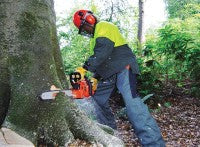 Whilst some local authorities run vibration checks in-house the majority turn to independent testing houses to produce reports on machinery and equipment for them. So, too, do machinery and equipment manufacturers, anxious to demonstrate that they can back up the health and safety claims they make for their products.
Whilst some local authorities run vibration checks in-house the majority turn to independent testing houses to produce reports on machinery and equipment for them. So, too, do machinery and equipment manufacturers, anxious to demonstrate that they can back up the health and safety claims they make for their products.
Sports clubs are beginning to realise the importance of independent data in assessing noise and vibration risks, but much still needs to be done to raise awareness among end users.
Earlsmere ID Systems Fivesquared division, an independent test house and consultancy in the UK, offers hand-arm vibration (HAV) and whole body vibration (WBV) testing, noise and PAT checks, as well as vibration management and reduction solutions to clients across the industry that include local authorities, grounds maintenance contractors, engineering service companies and major construction firms.
"We offer the complete service to help inform people about HAV and WBV, providing information, training, testing and software," says Fivesquared's Jeremy Hoyle.
A key issue currently is the vibration at work regulation that came into effect in July 2005, replacing 1989 legislation, and the control of noise at work measure that came into force in April 2006.
"The aim of the noise regulations is to ensure that workers' hearing is guarded against excessive noise at their place of work which, if not properly protected, could cause them to lose hearing and/or to suffer from tinnitus," he adds.
Levels at which employers must provide hearing protection and hearing protection zones is now 85 decibels (daily or weekly average exposure) and the level at which employers must assess the risk to workers' health and provide them with information and training is set at 80 decibels.
An exposure limit value of 87 decibels takes into account any reduction in exposure that hearing protection provides, Hoyle adds.
"The Control of Vibration at Work Regulations 2005 introduced action and limit values for hand-arm and whole-body vibration," he continues. For HAV, the regulations introduced an exposure action value of 2.5m/s2 A(8) (metres per second squared - average 8 hours use per day), at which level employers should introduce technical and organisational measures to reduce exposure, while the limit value of 5.0m/s2 A(8) should not be exceeded.
"The regulations allow a transitional period until 2010 for the exposure limit value for hand-arm vibration to come into force. This is to allow work activities, where the use of older tools and machinery cannot keep exposures below the limit value, to comply," he points out.
Jeremy Hoyle talks of major concerns, which he believes need to be addressed when using machinery. "One of the most pressing concerns is, if equipment is not serviced and maintained on a regular basis, the vibration level can, and usually does, increase."
"Also, using products that are not of a good quality can also increase vibration, as well as noise in some cases. The requirement for correct provision of PPE and checks to ensure that operators wear it and look after it correctly is paramount."
The company hopes to help address such issues with its Toolminder software, said to make machine safety easier for the industry to manage and allowing sites to select more confidently the correct PPE for their needs.
"We have compiled over 14,000 test statistics from testing work carried out in the UK and Europe under actual working conditions, so our clients can have accurate data on hand," says Hoyle. "When we test a machine with clients, we always carry the testing process out in realistic conditions, with at least one of the end users and on the type of terrain they will be working on, which allows our data to be as accurate as possible."
Those who shun the notion that HAV is an issue in groundcare, should take note of the survey Fivesquared conducted late last year. Results indicated that most golf clubs and organisations within the fine turf industry were not doing nearly as much as they should be. Their findings revealed that, on average, one in two golf clubs didn't think they had a problem with HAV at all. A worrying statistic for sure.
Pain in the pocket
Hoyle crystallises the stark implications of such a lack of awareness of the dangers. "A recent court case with a club in the Midlands was settled when an employee claimed for white finger and was awarded more than £15,000, demonstrating not only how important safety is for the health of employees, but also how costly it can prove to be when the rules are flouted."
"Safety regulations are ultimately there to protect employers and employees," he adds. "Health and safety has to work for the organisation implementing the regulations, sometimes though these are open to interpretation. All staff members should want to work in the safest way possible but, sometimes, the regulations and safety regime that golf clubs, for example, implement are seen as a hindrance by some staff members, and this should not be the case."
The reality is that a wealth of free or inexpensive advice is available that Hoyle says "could help rid much of the confusion in the industry".
"We have carried out full vibration management programmes nationwide for a number of clubs who take health and safety seriously and want to offer full protection to their employees. Putting a system in place also protects the golf club from claims and may reduce insurance premiums. A 'full system' can cost as little as £400-500 depending on the number of tools and equipment used on site," Hoyle says.
Finger of blame
White finger remains a persistent problem in the industry, according to Hoyle. "The fact is, no effective PPE exists for it. Several glove manufactures claim that their product will help prevent HAVs, but we have not yet come across one that meets the required standards. Any glove that keeps the hand warm and dry, and doesn't make you increase grip strength to use the equipment, will suffice."
"Simply not enough is in place in the industry to help guard against damage like white finger. Most golf clubs either are not aware of the issues or they think it doesn't affect them."
The industry is still reportedly witnessing cases of greenkeepers working on hand-held machines for four or five hours a day, ignorant of the damage they could be inflicting on themselves if using high vibration tools and equipment.
Hoyle wants to turn things around as a matter of urgency. "In some instances, golf clubs might not be aware of the dangers but, unfortunately, this is not good enough anymore. In a court of law, ignorance is no defence."
Driving up training standards
 Professional grounds maintenance machinery manufacturers, Dennis, are known for their 'customer driven' design policy, low noise and vibration characteristics and for producing machines that are versatile and comfortable.
Professional grounds maintenance machinery manufacturers, Dennis, are known for their 'customer driven' design policy, low noise and vibration characteristics and for producing machines that are versatile and comfortable.
Noise and vibration reduction are issues close to the heart of managing director, Ian Howard, who is keen to reveal the dangers. "We continually look at ways to improve health and safety on all of our existing products, and this is an integral part of new product development," he confirms.
"Taking noise and vibration as examples, we now utilise Honda's latest low noise, low vibration engine type, Q9. While this engine is more expensive than the standard version (Q4), noise is dramatically lower. The Q9 looks no different, but the porting for exhaust gases and other internal features have made this significant reduction."
Honda has spent millions of pounds on this type of improvement, driven by the strict emission laws in US states such as California, Ian says. "Lower noise also means lower vibration, so this choice to uprate by us means less vibration in the machine that we have to isolate from the operator."
Sounds simple enough but, as Ian contends, the real work goes on behind the scenes and end users may be unaware of the level of specialist input ploughed into such improvements.
 "Solving vibration is a complex science. We have spent a considerable amount of time with external consultants, including universities and QuinetiQ, a company who provide research, technical advice, technology solutions and services to customers in core markets of defence and security."
"Solving vibration is a complex science. We have spent a considerable amount of time with external consultants, including universities and QuinetiQ, a company who provide research, technical advice, technology solutions and services to customers in core markets of defence and security."
"These findings give us a better understanding of the issues and solutions concerned. It is essential to keep the machine user friendly and without compromise in performance. Our handlebars are now all designed with low vibration as the key focus."
Dennis conduct a number of research and development initiatives into health and safety, and projects planned for 2010 include working on engine vibration reduction.
"If we can further limit engine vibration, we can reduce the machine vibration experienced by the operator. The big problem is that the frequency of the harmful vibration is exactly the frequency of the internal combustion engine used on pedestrian and ride-on machinery, but we have no alternative technology to use in a cost-effective way."
Their studies have revealed that regular maintenance of products is essential, demonstrating that items such as worn bearings can dramatically increase noise and vibration on machines.
"Training is essential to ensure the customer knows how to get the best performance through regular maintenance, as well as long life and minimal noise and vibration from the machines," Ian argues.
Part of the secret of sound health and safety in the workplace lies in manufacturing "strong, well-built machines that perform their design function with comfort and ease of use", he adds. "Effective health and safety training on how to operate pedestrian machines is essential. Safe, easy to use and comfortable controls are vital. If you develop a safety lever that everyone finds difficult to use, all you end up with is elastic bands or tape on the handles. It's a fine balance."
"Many of our operators are familiar with our machines and have respect for them. Some youngsters have never operated anything like a mower before, and so there is no appreciation of potential injury if the machine is misused. On the other hand, many accidents are caused by a blasé attitude. Compulsory training is essential to everyone."
 But noise is not really the issue for operators, argues Harry Handkammer, Managing Director of Countax.
But noise is not really the issue for operators, argues Harry Handkammer, Managing Director of Countax.
"The whole thing has gone far enough. We don't have a noise pollution problem. When was the last time you heard a chainsaw?"
Harry questions the very definition of noise. "In Germany, you cannot mow the lawn on a Sunday because it's a day of rest there, and people see it as intrusive. Here, we love the sound of grass being mown, don't we?"
Which, he argues, is the whole point. "Guidance on noise emission levels is designed with "the neighbour" in mind, not the operator.
Vibration levels on machinery and hand tools present a different challenge, he believes. "White finger is serious and is incurable - nerve endings in your fingers die. It can develop quite quickly too. So, controlling vibration levels is one of the forms of legislation that really matters."
He is acutely worried about the dangers of conditions such as white finger. Legislation may be tightening, and health and safety elements on machinery and equipment improving, but other issues blight the industry and put operators at risk, possibly without them even being alive to the dangers.
EU directives are largely dictating the way forward for safe practices, but product coming into Britain from outside Europe may not be as safe as the manufacturer claims.
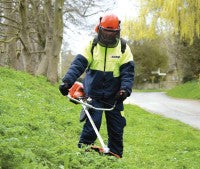 "This is the single biggest issue we face," Harry insists. "No regulations govern the importation of products. They may carry a C mark and, on paper, meet all regulations but, when tested, emission levels may be above legal limits and that, too, is becoming a major environmental factor."
"This is the single biggest issue we face," Harry insists. "No regulations govern the importation of products. They may carry a C mark and, on paper, meet all regulations but, when tested, emission levels may be above legal limits and that, too, is becoming a major environmental factor."
Moves are afoot to develop global legislation, but there are snags. "In the US, no noise legislation exists at all. Mowers there, for example, may be twice as loud, so they are not going to speed the introduction of controls, are they?"
The reality is clear - if machinery and equipment tick the boxes, it is seen as meeting standards, he says. "We are policing documentation not product. That's why it is so important to conduct independent tests over here. The Vehicle Documentation Authority will check the paperwork, but not the product itself."
UK manufacturers such as Countax are bearing the brunt of laxness abroad, says Harry, who is conscious that his protestations could sound like sour grapes. "It's not a level playing field. We spend a lot more money making products that meet legal limits. For example, the costs of making a quiet ride-on tractor are extremely high. You're looking at double skin bonnets and soft joints and, to do that, is expensive. We are losing £250,000 a year off the bottom line in such added costs."
Countax employs Fivesquared to conduct regular checks on products and to supply vibration data for the machines and tools they supply here. "There's a document for every product we sell," he says.
But, Harry sees little point in introducing still more legislation before existing measures have been adequately sorted. "Second stage noise directives have been rolling around for years, but we are fighting a second layer of law when the first layer is still not being policed properly."
Countax works closely with Japanese and US manufacturers on raising the health and safety bar still higher on Echo power tools, which it supplies here. "They have set the standards for many other manufacturers," he claims
Such thoroughness is vital for industry standards to become universally high, and for risks in use to be minimised, he maintains. "I've seen products quoted as generating a certain vibration level but, when tested by local authorities before use, they are rejected for not meeting legal limits."
"Operators should be being told daily about the restrictions of using equipment such as power tools and mowers," says Harry, "but end users such as clubs and councils should have the proof that they have been tested, and that operators are safe to use them over the prescribed time."
"Contractors need to have that information and Insurance companies will want to know that the required risk assessments have been undertaken," he adds.
Despite the misgivings of Harry Handkammer and other UK manufacturers, Britain can boast a good safety record. "One of the best in the world," he confirms. "Double action mowers and power tools have been available for some time now, and heighten operator safety."
But even vibration testing is questioned by some, he adds. "The benchmark is still to be set, because the method of testing is not universally agreed yet."
Even the dangers that older machines pose is open to interpretation. "A machine can become quieter with use, as parts wear in and become smoother when in operation."
So, don't ditch that old faithful just yet. An independent test on it might reveal that age is not a risk factor.
Dealer detail.
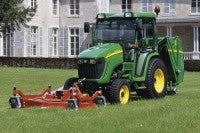 Tony Jenkins, of FG Adamson & Sons, recently supplied two machines to Bishop Burton College in Beverley, East Yorkshire, a partly land based college who are currently undergoing a multi million pound machine investment.
Tony Jenkins, of FG Adamson & Sons, recently supplied two machines to Bishop Burton College in Beverley, East Yorkshire, a partly land based college who are currently undergoing a multi million pound machine investment.
"We supplied them with a John Deere 3520 compact tractor, which comes with a number of important safety features - a rubber isolated platform which minimises vibration, an operator presence system that will shut the tractor off if the operator leaves the seat while the tractor is in gear, an ASAE and OSHA certified roll-over protective structure, and wide angle halogen lights providing more light and better light dispersion.
We also supplied them with a John Deere X748 tractor. This was the first time they purchased a ride on machine from us, but we have dealt with them for tractors before."
Good instructor training can be invaluable to those purchasing new machines, and having a good knowledge of its functions is a big step towards reducing injuries caused from improper machine use. "Our training basically involves making the user aware of the entire machine controls, how to use them correctly, and what safety precautions are to be taken. This is essential as, often, the end users don't know how to use the machines as well as they think they might. No matter how experienced a groundsman may be, the initial instructor training is always essential for safe use."
John Deere machines come with a 20 point check list in conjunction with HSE, which outlines all the procedures one should follow before using a piece of kit, including necessary PPE equipment.
"The college opted to do all the maintenance themselves along with our standard annual service. We do offer our customers a regular service but, with funds being what they are at present, it is understandable that people want to do more in house maintenance."
"The X series John Deere tractors have very low body vibration levels, which are vital if grounds staff are using machines for prolonged periods of time or used intensely for training purposes. Tractors operate under different vibration regulations than ride on mowers and other grass care machinery, due to the varying loads they might be carrying. If a tractor has an aerator attached to the back, the vibration levels are going to be sufficiently greater than if there was nothing at all - users need to take this into account."
"We recommend to our customers that machines are replaced every 2000-3000 miles on average, depending on the type of terrain it's used on and the levels of wear and tear it gets. Regular maintenance and correct machine use will usually ensure longevity of the machine as well as safety for the user."
Spotting Problems!
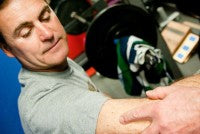 News that professional cricketers are being checked for early signs of skin cancer brings into focus whether grounds staff should also be checked routinely for the disease.
News that professional cricketers are being checked for early signs of skin cancer brings into focus whether grounds staff should also be checked routinely for the disease.
One of the most widespread of cancers, malignant melanoma, can be treated successfully if caught early, say specialists. Cases of the condition in Britain have risen dramatically in the last three decades, new figures reveal, to stand at 10,000 annually, a fourfold increase over that time.
Working with the Professional Cricketers Association (PCA), a network of clinics called Skin has conducted mole checks recently on cricketers at county clubs.
The results were surprising, not to say disturbing, with one in six cricketers tested reportedly referred to specialists with 'suspicious' moles.
"Melanoma is a killer but can be eradicated if a mole is changing but has not gone deep into the skin," says Dr Sean Lanigan, consultant dermatologist and medical director of Skin.
"Changes occur in most people due to sunburn reactions," he continues. "Sunburn in childhood, particularly in the under-16s, can be sufficient to trigger malignant melanoma, although repeated episodes are more dangerous than single episodes."
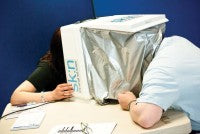 Those with white skin are more at risk, he adds, as are those with a large number of moles on their body or a familial link with the disease. The non-malignant form of melanoma is more common in older people, he adds, usually presenting on the face as sores or growths.
Those with white skin are more at risk, he adds, as are those with a large number of moles on their body or a familial link with the disease. The non-malignant form of melanoma is more common in older people, he adds, usually presenting on the face as sores or growths.
The risk is not confined to one sport. "This is a particular problem with cricketers, but golfers are also potentially at risk," said dermatologist Dr Robert Burd, speaking at Northamptonshire CCC, where Skin has conducted skin checks. "UV damage at an early age can certainly cause problems later on."
If cricketers are at risk from the sun, groundcare staff are even more so, believes Northamptonshire's head groundsman, Paul Marshall. "We are out there 24/7, all year," says the 42-year-old, who has been at the club for twenty years, seven of those in his present post.
"Four out of our team of five are sun worshippers, but only two put on sun cream. Personally, I never put any on - I suppose I should, but I wouldn't want to lather up in the morning for a fourteen hour day. It attracts the flies, midges and dust."
"I seem to remember that a groundsman died of skin cancer about 18 months ago, so I'd say that we are definitely at risk. Perhaps clubs should be checking us as well as the players."
Boom times!
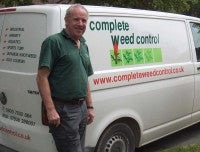 Under EU rules, the number of pesticides that are allowed to be used in the sports and amenity sectors is falling sharply, as concerns in the European Parliament over health risks to operators and the general public rise.
Under EU rules, the number of pesticides that are allowed to be used in the sports and amenity sectors is falling sharply, as concerns in the European Parliament over health risks to operators and the general public rise.
Local authorities are imposing ever more stringent conditions on contractors charged with the responsibility of applying chemicals to parks, pitches and stadia.
The application equipment itself should also be subject to rigorous health and safety guidelines, not least by the contractors themselves.
Complete Weed Control maintains longstanding relationships with some of Britain's largest local authorities, but know that policing health and safety guidelines and practices is the only way to ensure that such working partnerships persist.
"The vast majority of our application equipment is specially built for us to cover all the health and safety aspects," confirms CWC technical director, Alan Abel, who stresses that several key points need to be covered before operators can begin their work. These are:
• Ease of fitting the chemicals tank to the sprayer
• Layout of switches and the ergonomics of the cab to ensure safe and convenient position for the operator
• The type of spray control unit has to be exactly right for the application
• Attention to reducing the degree of yaw of the spray boom, which can increase to unsafe levels if the boom is too long, and could also result in a number of spray nozzles being broken at either end
"We usually buy John Deere Gator 4x4s, with a cab mounted on them, to reduce the amount of drift during spraying," Alan explains.
"Putting a good health and safety package in place from the start is paramount," he adds. "If you do, you are half way there, at a time when local authorities are checking this aspect of the contractor's service ever more closely."
That factor proved decisive when CWC tended for the Vale of Glamorgan contract recently, for which it had worked for a number of years. Its use of the Weed-It computer-controlled spray system was an important consideration, Alan adds. Infrared sensors detect chlorophyll, so only actuate the sprays to treat foliage when working on pavements and pathways for example. In a year, significantly less liquid is wasted.
"I would estimate that nearly a third of the strength of our winning the contract was due to our sound health and safety practices."
Standards across the sector are set to rise as the National Action Plan, due for publication next year, comes into force, and more spray operators become BASSIS certified.
